Geometric Morphometrics and Machine Learning Models Applied to the Study of Late Iron Age Cut Marks from Central Spain
Abstract
:1. Introduction
The Ulaca Oppidum
2. Materials and Methods
2.1. Sample
2.2. Methodology
Geometric Morphometrics and Statistics
3. Results
4. Discussion
5. Conclusions
Supplementary Materials
Author Contributions
Funding
Institutional Review Board Statement
Informed Consent Statement
Data Availability Statement
Acknowledgments
Conflicts of Interest
References
- Kaiser, T.M.; Katterwe, H. The application of 3D-microprofilometry as a tool in the surface diagnosis of fossil and sub-fossil vertebrate hard tissue. An example from the Pliocene Upper Laetolil Beds, Tanzania. Int. J. Osteoarchaeol. 2001, 11, 350–356. [Google Scholar] [CrossRef]
- Bello, S.M.; Soligo, C. A new method for the quantitative analysis of cutmark micromorphology. J. Archaeol. Sci. 2008, 35, 1542–1552. [Google Scholar] [CrossRef]
- Bello, S.M. New results from the examination of cut-marks using three-dimensional imaging. In Developments in Quaternary Sciences; Elsevier: Amsterdam, The Netherlands, 2011; Volume 14, pp. 249–262. [Google Scholar]
- Bello, S.M.; Parfitt, S.A.; Stringer, C. Quantitative micromorphological analyses of cut marks produced by ancient and modern handaxes. J. Archaeol. Sci. 2009, 36, 1869–1880. [Google Scholar] [CrossRef]
- Bello, S.M.; De Groote, I.; Delbarre, G. Application of 3-dimensional microscopy and micro-CT scanning to the analysis of Magdalenian portable art on bone and antler. J. Archaeol. Sci. 2013, 40, 2464–2476. [Google Scholar] [CrossRef]
- Bonney, H. An investigation of the use of discriminant analysis for the classification of blade edge type from cut marks made by metal and bamboo blades. Am. J. Phys. Anthropol. 2014, 154, 575–584. [Google Scholar] [CrossRef]
- Boschin, F.; Crezzini, J. Morphometrical analysis on cut marks using a 3D digital microscope. Int. J. Osteoarchaeol. 2012, 22, 549–562. [Google Scholar] [CrossRef]
- Courtenay, L.A.; Yravedra, J.; Mate-González, M.Á.; Aramendi, J.; González-Aguilera, D. 3D analysis of cut marks using a new geometric morphometric methodological approach. Archaeol. Anthropol. Sci. 2019, 11, 651–665. [Google Scholar] [CrossRef]
- Courtenay, L.A.; Maté-González, M.Á.; Aramendi, J.; Yravedra, J.; González-Aguilera, D.; Domínguez-Rodrigo, M. Testing accuracy in 2D and 3D geometric morphometric methods for cut mark identification and classification. PeerJ 2018, 6, e5133. [Google Scholar] [CrossRef] [Green Version]
- Courtenay, L.A.; Yravedra, J.; Huguet, R.; Ollé, A.; Aramendi, J.; Maté-González, M.Á.; González-Aguilera, D. New taphonomic advances in 3D digital microscopy: A morphological characterisation of trampling marks. Quat. Int. 2019, 517, 55–66. [Google Scholar] [CrossRef]
- Courtenay, L.A.; Yravedra, J.; Aramendi, J.; Maté-González, M.Á.; Martín-Perea, D.M.; Uribelarrea, D.; Baquedano, E.; González-Aguilera, D.; Domínguez-Rodrigo, M. Cut marks and raw material exploitation in the lower pleistocene site of Bell’s Korongo (BK, Olduvai Gorge, Tanzania): A geometric morphometric analysis. Quat. Int. 2019, 526, 155–168. [Google Scholar] [CrossRef]
- Courtenay, L.A.; Yravedra, J.; Huguet, R.; Aramendi, J.; Maté-González, M.Á.; González-Aguilera, D.; Arriaza, M.C. Combining machine learning algorithms and geometric morphometrics: A study of carnivore tooth marks. Palaeogeogr. Palaeoclimatol. Palaeoecol. 2019, 522, 28–39. [Google Scholar] [CrossRef]
- Courtenay, L.A.; Herranz-Rodrigo, D.; González-Aguilera, D.; Yravedra, J. Developments in data science solutions for carnivore tooth pit classification. Sci. Rep. 2021, 11, 1–15. [Google Scholar] [CrossRef]
- Courtenay, L.A.; Yravedra, J.; Herranz-Rodrigo, D.; Rodríguez-Alba, J.J.; Serrano-Ramos, A.; Estaca-Gómez, V.; González-Aguilera, D.; Solano, J.A.; Jiménez-Arenas, J.M. Deciphering carnivoran competition for animal resources at the 1.46 Ma early Pleistocene site of Barranco León (Orce, Granada, Spain). Quat. Sci. Rev. 2023, 300, 107912. [Google Scholar] [CrossRef]
- Maté González, M.Á.; Yravedra, J.; González-Aguilera, D.; Palomeque-González, J.F.; Domínguez-Rodrigo, M. Micro-photogrammetric characterization of cut marks on bones. J. Archaeol. Sci. 2015, 62, 128–142. [Google Scholar] [CrossRef]
- Maté-González, M.Á.; Palomeque-González, J.F.; Yravedra, J.; González-Aguilera, D.; Domínguez-Rodrigo, M. Micro-photogrammetric and morphometric differentiation of cut marks on bones using metal knives, quartzite, and flint flakes. Archaeol. Anthropol. Sci. 2018, 10, 805–816. [Google Scholar] [CrossRef]
- Maté-González, M.Á.; Aramendi, J.; Yravedra, J.; Blasco, R.; Rosell, J.; González-Aguilera, D.; Domínguez-Rodrigo, M. Assessment of statistical agreement of three techniques for the study of cut marks: 3D digital microscope, laser scanning confocal microscopy and micro-photogrammetry. J. Microsc. 2017, 267, 356–370. [Google Scholar] [CrossRef]
- Maté-González, M.Á.; Aramendi, J.; González-Aguilera, D.; Yravedra, J. Statistical comparison between low-cost methods for 3D characterization of cut-marks on bones. Remote Sens. 2017, 9, 873. [Google Scholar] [CrossRef] [Green Version]
- Maté-González, M.Á.; Yravedra, J.; Martín-Perea, D.M.; Palomeque-González, J.; San-Juan-Blázquez, M.; Estaca-Gómez, V.; Uribelarrea, D.; Álvarez-Alonso, D.; Cuartero, F.; González-Aguilera, D.; et al. Flint and quartzite: Distinguishing raw material through bone cut marks. Archaeometry 2018, 60, 437–452. [Google Scholar] [CrossRef]
- Maté-González, M.Á.; Courtenay, L.A.; Aramendi, J.; Yravedra, J.; Mora, R.; González-Aguilera, D.; Domínguez-Rodrigo, M. Application of geometric morphometrics to the analysis of cut mark morphology on different bones of differently sized animals. Does size really matter? Quat. Int. 2019, 517, 33–44. [Google Scholar] [CrossRef]
- Aramendi, J.; Maté-González, M.A.; Yravedra, J.; Cruz Ortega, M.; Arriaza, M.C.; González-Aguilera, D.; Baquedano, E.; Domínguez-Rodrigo, M. Discerning carnivore agency through the three-dimensional study of tooth pits: Revisiting crocodile feeding behaviour at FLKZinj and FLK NN3 (Olduvai Gorge, Tanzania). Palaeogeogr. Palaeoclimatol. Palaeoecol. 2017, 488, 93–102. [Google Scholar] [CrossRef]
- Pante, M.C.; Muttart, M.V.; Keevil, T.L.; Blumenschine, R.J.; Njau, J.K.; Merritt, S.R. A new high-resolution 3-D quantitative method for identifying bone surface modifications with implications for the Early Stone Age archaeological record. J. Hum. Evol. 2017, 102, 1–11. [Google Scholar] [CrossRef]
- Linares-Matás, G.J.; Yravedra, J.; Maté-González, M.Á.; Courtenay, L.A.; Aramendi, J.; Cuartero, F.; González-Aguilera, D. A geometric-morphometric assessment of three-dimensional models of experimental cut-marks using flint and quartzite flakes and handaxes. Quat. Int. 2019, 517, 45–54. [Google Scholar] [CrossRef]
- López-Cisneros, P.; Linares-Matás, G.; Yravedra, J.; Maté-González, M.Á.; Estaca-Gómez, V.; Mora, R.; Aramendi, J.; Rodríguez Asensio, J.A.; Barrera-Logares, J.M.; González-Aguilera, D. Applying new technologies to the taphonomic study of La Lluera (Asturias, Spain). Geometric morphometrics and the study of bone surface modifications (BSM). Quat. Int. 2019, 517, 107–117. [Google Scholar] [CrossRef]
- Pineda, A.; Courtenay, L.A.; Téllez, E.; Yravedra, J. An experimental approach to the analysis of altered cut marks in archaeological contexts from Geometrics Morphometrics. J. Archaeol. Sci. Rep. 2023, 48, 103850. [Google Scholar] [CrossRef]
- Yravedra, J.; García Vargas, E.; Maté González, M.Á.; Aramendi, J.; Palomeque-González, J.; Vallés-Iriso, J.; Matasanz-Vicente, J.; González-Aguilera, D.; Domínguez-Rodrigo, M. The use of Micro-Photogrammetry and Geometric Morphometrics for identifying carnivore agency in bone assemblage. J. Archaeol. Sci. Rep. 2017, 14, 106–115. [Google Scholar] [CrossRef]
- Yravedra, J.; Maté-González, M.Á.; Palomeque-González, J.F.; Aramendi, J.; Estaca-Gómez, V.; San-Juan-Blázquez, M.; García Vargas, E.; Organista, E.; González-Aguilera, D.; Arriaza, M.C.; et al. A new approach to raw material use in the exploitation of animal carcasses at BK (upper bed II, Olduvai gorge, Tanzania): A micro-photogrammetric and geometric morphometric analysis of fossil cut marks. Boreas 2017, 46, 860–873. [Google Scholar] [CrossRef]
- Yravedra, J.; Diez-Martín, F.; Egeland, C.P.; Maté-González, M.Á.; Palomeque-González, J.F.; Arriaza, M.C.; Aramendi, J.; García Vargas, E.; Estaca-Gómez, V.; Sánchez, P.; et al. FLK West (Lower Bed II, Olduvai Gorge, Tanzania): A new early Acheulean site with evidence for human exploitation of fauna. Boreas 2017, 46, 816–830. [Google Scholar] [CrossRef]
- Yravedra, J.; Aramendi, J.; Maté-González, M.Á.; Courtenay, L.A.; González-Aguilera, D. Differentiating percussion pits and carnivore tooth pits using 3D reconstructions and geometric morphometrics. PLoS ONE 2018, 13, e0194324. [Google Scholar] [CrossRef] [Green Version]
- Yravedra, J.; Maté-González, M.Á.; Courtenay, L.A.; López-Cisneros, P.; Estaca-Gómez, V.; Aramendi, J.; de Andrés-Herrero, M.; Linares-Matás, G.; González-Aguilera, D.; Álvarez-Alonso, D. Approaching raw material functionality in the Upper Magdalenian of Coímbre cave (Asturias, Spain) through geometric morphometrics. Quat. Int. 2019, 517, 97–106. [Google Scholar] [CrossRef]
- Yravedra, J.; Maté-González, M.Á.; Courtenay, L.A.; González-Aguilera, D.; Fernández Fernández, M. The use of canid tooth marks on bone for the identification of livestock predation. Sci. Rep. 2019, 9, 16301. [Google Scholar] [CrossRef] [Green Version]
- Yravedra, J.; Courtenay, L.A.; Herranz-Rodrigo, D.; Rodríguez-Alba, J.J.; Linares-Matás, G.; Estaca-Gómez, V.; Maté-González, M.Á.; Luzón, C.; Serrano-Ramos, A.; Solano, J.A.; et al. Taphonomic characterisation of tooth marks of extinct Eurasian carnivores through GeometricMorphometric. Science 2022, 67, 1644–1648. [Google Scholar]
- Otárola-Castillo, E.; Torquato, M.G.; Hawkins, H.C.; James, E.; Harris, J.A.; Marean, C.W.; McPhernon, S.; Thompson, J.C. Differentiating between cutting actions on bone using 3D geometric morphometrics and Bayesian analyses with implications to human evolution. J. Archaeol. Sci. 2018, 89, 56–67. [Google Scholar] [CrossRef]
- Arriaza, M.C.; Aramendi, J.; Maté-González, M.Á.; Yravedra, J.; Stratford, D. The hunted or the scavenged? Australopith accumulation by brown hyenas at Sterkfontein (South Africa). Quat. Sci. Rev. 2021, 273, 107252. [Google Scholar] [CrossRef]
- Calder, J.; Coil, R.; Melton, J.A.; Olver, P.J.; Tostevin, G.; Yezzi-Woodley, K. Use and misuse of machine learning in anthropology. IEEE BITS Inf. Theory Mag. 2022, 2, 102–115. [Google Scholar] [CrossRef]
- Shipman, P. Applications of scanning electron microscopy to taphonomic problems. Ann. N. Y. Acad. Sci. 1981, 376, 357–385. [Google Scholar] [CrossRef]
- Olsen, S. The identification of stone and metal toolmarks on bone artifacts. Scanning Electron Microsc. Archaeol. 1988, 452, 337–360. [Google Scholar]
- Greenfield, H.J. The origins of metallurgy: Distinguishing stone from metal cut-marks on bones from archaeological sites. J. Archaeol. Sci. 1999, 26, 797–808. [Google Scholar] [CrossRef]
- Greenfield, H.J. Slicing cut marks on animal bones: Diagnostics for identifying stone tool type and raw material. J. Field Archaeol. 2006, 31, 147–163. [Google Scholar] [CrossRef]
- Yravedra, J.; Morín, J.; Agustí, E.; Sanabria, P.; López, M.; Urbina, D.; López- Frailes, F.J.; López, G.; Illán, J. Implicaciones metalúrgicas de las marcas de corte en la transición Bronce Final/Hierro en el interior de la Península Ibérica. Gallaecia Rev. de Arqueol. Antigüidade 2009, 28, 77–92. [Google Scholar]
- Estaca-Gómez, V.; Rodríguez-Hernández, J.; Gómez-Hernández, R.; Yravedra, J.; Ruiz-Zapatero, G.; Álvarez-Sanchis, J.R. Zooarchaeology of the Iron Age in Western Iberia: New insights from the Celtic oppidum of Ulaca. Archaeol. Anthropol. Sci. 2022, 14, 168. [Google Scholar] [CrossRef]
- Ruiz Zapatero, G. Castro de Ulaca. Solosancho, Ávila; Institución Gran Duque de Alba: Ávila, Spain, 2005. [Google Scholar]
- Maté-González, M.Á.; Rodríguez-Hernández, J.; Sáez Blázquez, C.; Troitiño Torralba, L.; Sánchez-Aparicio, L.J.; Fernández Hernández, J.; Herrero Tejedor, T.R.; Fabián García, J.F.; Piras, M.; Díaz-Sánchez, C.; et al. Challenges and Possibilities of Archaeological Sites Virtual Tours: The Ulaca Oppidum (Central Spain) as a Case Study. Remote Sens. 2022, 14, 524. [Google Scholar] [CrossRef]
- Ruiz Zapatero, G.; Álvarez-Sanchís, J.R.; Rodríguez-Hernández, J. Urbanism in Iron Age Iberia: Two Worlds in Contact. J. Urban Archaeol. 2020, 1, 123–150. [Google Scholar] [CrossRef]
- Álvarez-Sanchís, J.R.; Jimeno Martínez, A.; Ruiz Zapatero, G. (Eds.) Aldeas y Ciudades en el Primer Milenio a.C. La Meseta Norte y los Orígenes del Urbanismo. In Complutense; University of Madrid: Madrid, Spain, 2011; Volume 22. [Google Scholar]
- Maté-González, M.Á.; Sáez Blázquez, C.; Carrasco García, P.; Rodríguez-Hernández, J.; Fernández Hernández, J.; Vallés Iriso, J.; Torres, Y.; Troitiño Torralba, L.; Courtenay, L.A.; González-Aguilera, D.; et al. Towards a Combined Use of Geophysics and Remote Sensing Techniques for the Characterization of a Singular Building: “El Torreón” (the Tower) at Ulaca Oppidum (Solosancho, Ávila, Spain). Sensors 2021, 21, 2934. [Google Scholar] [CrossRef]
- Almagro-Gorbea, M.; Álvarez-Sanchís, J.R. La sauna de Ulaca: Saunas y baños iniciáticos en el mundo céltico. Cuad. De Arqueol. De La Univ. De Navar. 1993, 1, 177–253. [Google Scholar] [CrossRef]
- Rodríguez-Hernández, J. Los procesos técnicos de la cantería durante la Segunda Edad del Hierro en el occidente de la Meseta. Zephyrus 2012, 70, 113–130. [Google Scholar]
- Álvarez-Sanchís, J.R. Oppida and Celtic society in western Spain. e-Keltoi 2005, 6, 255–285. [Google Scholar]
- Álvarez-Sanchís, J.R.; Marín, C.; Falquina, A.; Ruiz Zapatero, G. El oppidum vettón de Ulaca (Solosancho, Ávila) y su necrópolis. In Arqueología Vettona. La Meseta Occidental en la Edad del Hierro; Álvarez-Sanchís, J.R., Ed.; Museo Arqueológico Regional, Alcalá de Henares: Madrid, Spain, 2008; pp. 338–361. [Google Scholar]
- Rodríguez-Hernández, J. Poder y sociedad: El oeste de la Meseta en la Edad del Hierro; Institución Gran Duque de Alba: Ávila, Spain, 2019. [Google Scholar]
- Blanco González, A. Tendencias del uso del suelo en el Valle Amblés (Ávila, España). De la Edad del Hierro al Medievo. Zephyrus 2009, 63, 155–183. [Google Scholar]
- Binford, L.R. Bones: Ancient Men and Modern Myths; Academic Press Inc.: New York, NY, USA, 1981. [Google Scholar]
- Shipman, P. Life Historia of a Fossil. an Introduction to Taphonomy and Paleoecology; Harvard University Press: Cambridge, MA, USA; London, UK, 1981; p. 222. [Google Scholar]
- O’Higgins, P.; Johnson, D.R. The quantitative description and comparison of biological forms. Cr. Rev. Anat. Sci. 1998, 1, 149–170. [Google Scholar]
- Bookstein, F.L. Morphometric Tools for Landmark Data: Geometry and Biology; Cambridge University Press: New York, NY, USA, 1991. [Google Scholar]
- Hall, B.K. Descent with modification: The unity underlying homology and homoplasy as seen through an analysis of development and evolution. Biol. Rev. 2003, 78, 409–433. [Google Scholar] [CrossRef]
- Klingenberg, C.P. Novelty and “Homology-free” Morphometrics: What’s in a Name? Evol. Biol. 2008, 35, 186–190. [Google Scholar] [CrossRef]
- Rohlf, F.J. Shape Statistics: Procrustes Superimpositions and Tangent Spaces. J. Classif. 1999, 16, 197–223. [Google Scholar] [CrossRef]
- Slice, D.E. Landmark Coordinates Aligned by Procrustes Analysis Do Not Lie in Kendall’s Shape Space. Syst. Biol. 2001, 50, 141–149. [Google Scholar] [CrossRef] [PubMed]
- Richtsmeier, J.T.; Deleon, V.B.; Lele, S.R. The promise of geometric morphometrics. Am. J. Phys. Anthropol. 2002, 45, 63–91. [Google Scholar] [CrossRef] [PubMed]
- Bookstein, F.L. Principal warps: Thin-plate spline and the decomposition of deformations. IEEE Trans. Pattern Anal. Mach. Intell. 1989, 11, 567–585. [Google Scholar] [CrossRef] [Green Version]
- Kuhn, M. “Caret” Package: Classification and Regression Training; R Package Version 6.0-93. 2022. Available online: https://cran.r-project.org/web/packages/caret/caret.pdf (accessed on 2 February 2023).
- Bergstra, J.; Bengio, Y. Random Search for Hyper-Parameter Optimization Yoshua Bengio. J. Mach. Learn. Res. 2012, 13, 281–305. [Google Scholar]
- Snoek, J.; Larochelle, H.; Adams, R.P. Practical Bayesian Optimization of Machine Learning Algorithms. arXiv 2012, arXiv:1203.2944. [Google Scholar]
- Shahriari, B.; Swersky, K.; Wang, Z.; Adams, R.P.; De Freitas, N. Taking the human out of the loop: A review of Bayesian optimization. Proc. IEEE 2016, 104, 148–175. [Google Scholar] [CrossRef] [Green Version]
- Venables, W.N.; Ripley, B.D. Modern Applied Statistics with S; Springer: New York, NY, USA, 2002. [Google Scholar]
- Mohd Razali, N.; Bee Wah, Y. Power comparisons of Shapiro-Wilk, Kolmogorov-Smirnov, Lilliefors and Anderson-Darling tests. J. Stat. Model. Anal. 2011, 2, 21–33. [Google Scholar]
- Höhle, J.; Höhle, M. Accuracy assessment of digital elevation models by means of robust statistical methods. ISPRS J. Photogramm. Remote Sens. 2009, 64, 398–406. [Google Scholar] [CrossRef] [Green Version]
- Courtenay, L.; Gonzalez-Aguilera, D.; Lagüela, S.; del Pozo, S.; Ruiz Méndez, C.; Barbero-García, I.; Román-Curto, C.; Cañueto, J.; Santos-Durán, C.; Cardeñoso-Álvarez, M.E.; et al. Hyperspectral Imaging and Robust Statistics in Non-Melanoma Skin Cancer Analysis. Biomed. Opt. Express 2021, 12, 5107–5127. [Google Scholar] [CrossRef]
- Rao, C.R. An asymptotic expansion of the distribution of Wilk’s criterion. Bull. L’institut. Int. Stat. 1951, 33, 177–180. [Google Scholar]
- Lantz, B. Machine Learning with R; Packt Publishing Ltd.: Birmingham, UK, 2013. [Google Scholar]
- R Core-Team. A Language and Environment for Statistical Computing; R Foundation for Statistical Computing: Vienna, Austria, 2013; Available online: https://www.Rproject.org/ (accessed on 9 July 2015).
- Adams, D.; Collyer, M.; Kaliontzopoulou, A.; Baken, E. Geomorph: Geometric Morphometric Analyses of 2D/3D Landmark Data. R Package Version 4.0.4. 2022. Available online: https://cran.r-project.org/web/packages/geomorph/geomorph.pdf (accessed on 2 February 2023).
- Courtenay, L.A. GraphGMM v.1.0.0. Github. Available online: https://github.com/LACourtenay/GraphGMM (accessed on 2 February 2023).
- Hervé, M. “RVAideMemoire” Package: Testing and Plotting Procedures for Biostatistics. Version 0.9-81-2. Available online: https://cran.r-project.org/web/packages/RVAideMemoire/RVAideMemoire.pdf (accessed on 2 February 2023).
- Greenfield, H.J. Monitoring the origins of metallurgy: An application of cut mark analysis on animals bones from the Central Balkans. Environ. Archaeol. 2000, 5, 119–132. [Google Scholar] [CrossRef]
- Greenfield, H.J. Insufficient evidence for metal butchering marks at Tell el-Hesi during the Early Bronze Age: Critique of the analysis of microscopic grooves in ‘Cultural Modification Analyses on Faunal Remains in Relation to Space Use and Direct Provisioning from Field VI EBIIIA Tell el-Hesi’ by Kara Larson, James, W. Hardin, and Sara Cody. Palest. Explor. Q. 2021, 160, 144–155. [Google Scholar]
- Greenfield, H.J.; Brown, A. ‘Making the cut’: Changes in butchering technology and efficiency patterns from the Chalcolithic to modern Arab occupations at Tell Halif, Israel. In Bones and Identity: Zooarchaeological Approaches to Reconstructing Social and Cultural Landscapes in Southwest Asia; Marom, N., Yeshurun, R., Weissbrod, L., Bar-Oz, G., Eds.; Oxbow Press: Oxford, UK, 2016; pp. 273–291. [Google Scholar]
- Greenfield, H.J.; Beller, J.A.; Levy, T.E. Butchering technology during the Early Bronze Age I: An examination of microscopic cut marks on animal bones from Nahal Tillah, Israel. In Tell It in Gath: Studies in the History and Archaeology of Israel. Essays in Honor of A. M. Maeir on the Occasion of his Sixtieth Birthday, Ägypten und Altes Testament. Studien zu Geschichte, Kultur und Religion Ägyptens und des Alten Testaments; Band 90; Shai, I., Chadwick, J.R., Hitchcock, L., Dagam, A., McKinny, C., Uziel, J., Eds.; Zaphon: Münster, Germany, 2018; pp. 20–40. [Google Scholar]
- Greenfield, H.J.; Beller, J.A.; Gaastra, J. Changes in butchering technology and efficiency patterns between the Early and Middle Bronze Ages from Tell Zir¯a’a, Jordan. In Tall Zir¯a’a, The Gadara Region Project (2001–2011) Final Report: Early and Middle Bronze Age (Strata 25–17); Vieweger, D., Häser, J., Eds.; Deutsches Evangelisches Institut: Wuppertal, Germany, 2021; Volume 3. [Google Scholar]
- Okaluk, T.R.; Greenfield, H.J. Macroscopic Chop Mark Identification on Archaeological Bone: An Experimental Study of Chipped Stone, Ground Stone, Copper, and Bronze Axe Heads on Bone. Quaternary 2022, 5, 15. [Google Scholar] [CrossRef]
- Lyman, R.L. Vertebrate Taphonomy; Cambridge University Press: Cambridge, UK, 1994. [Google Scholar]
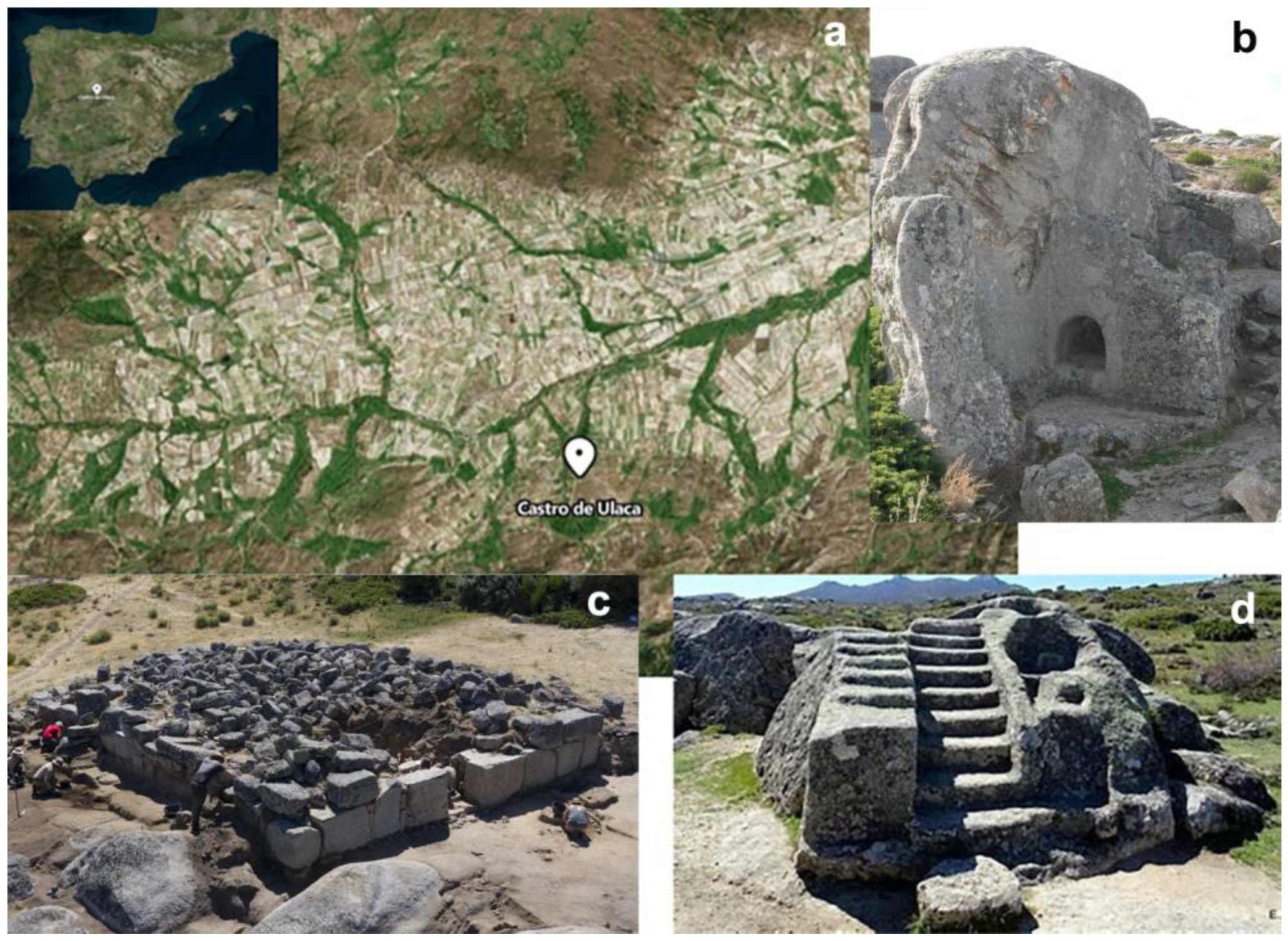
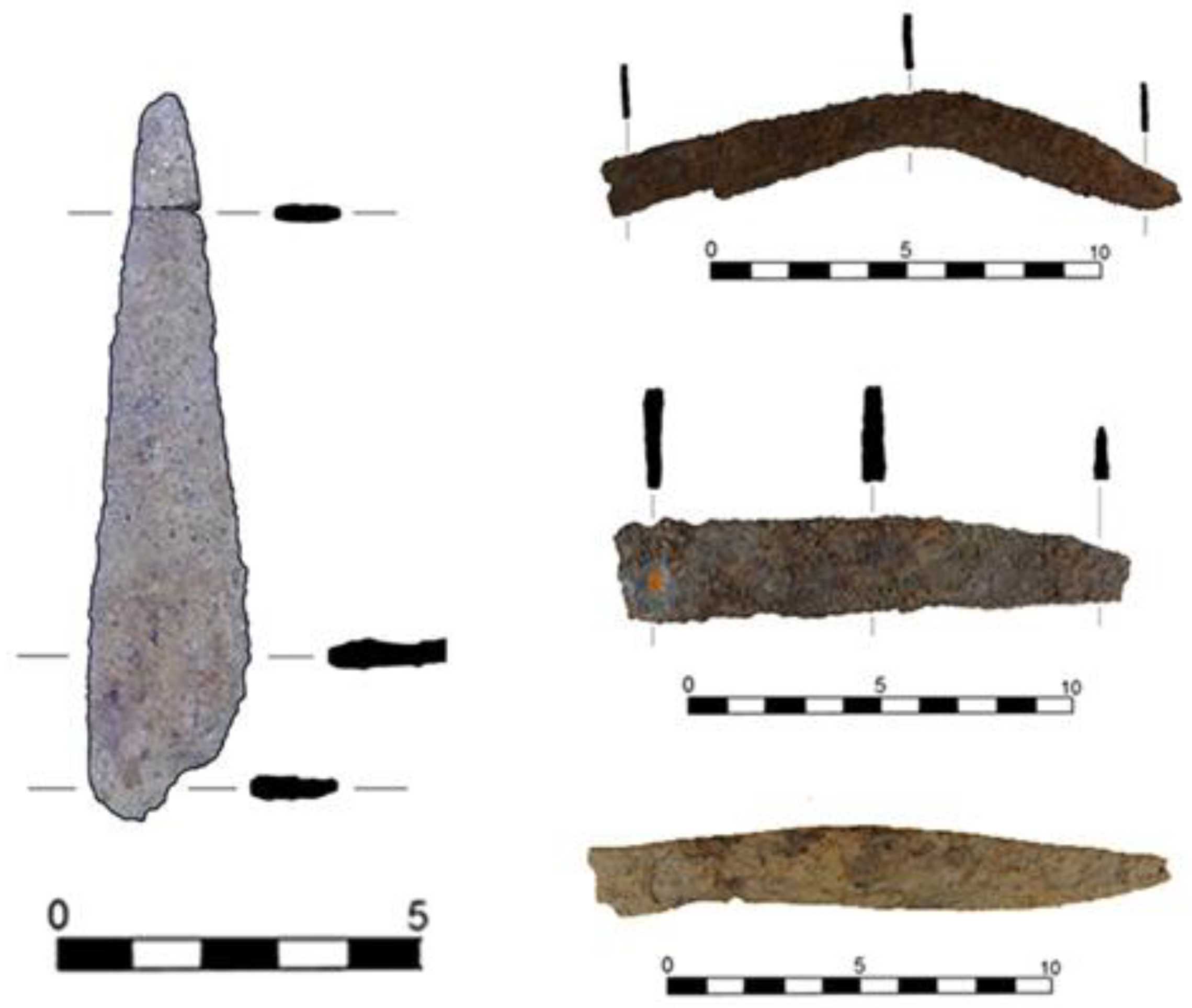
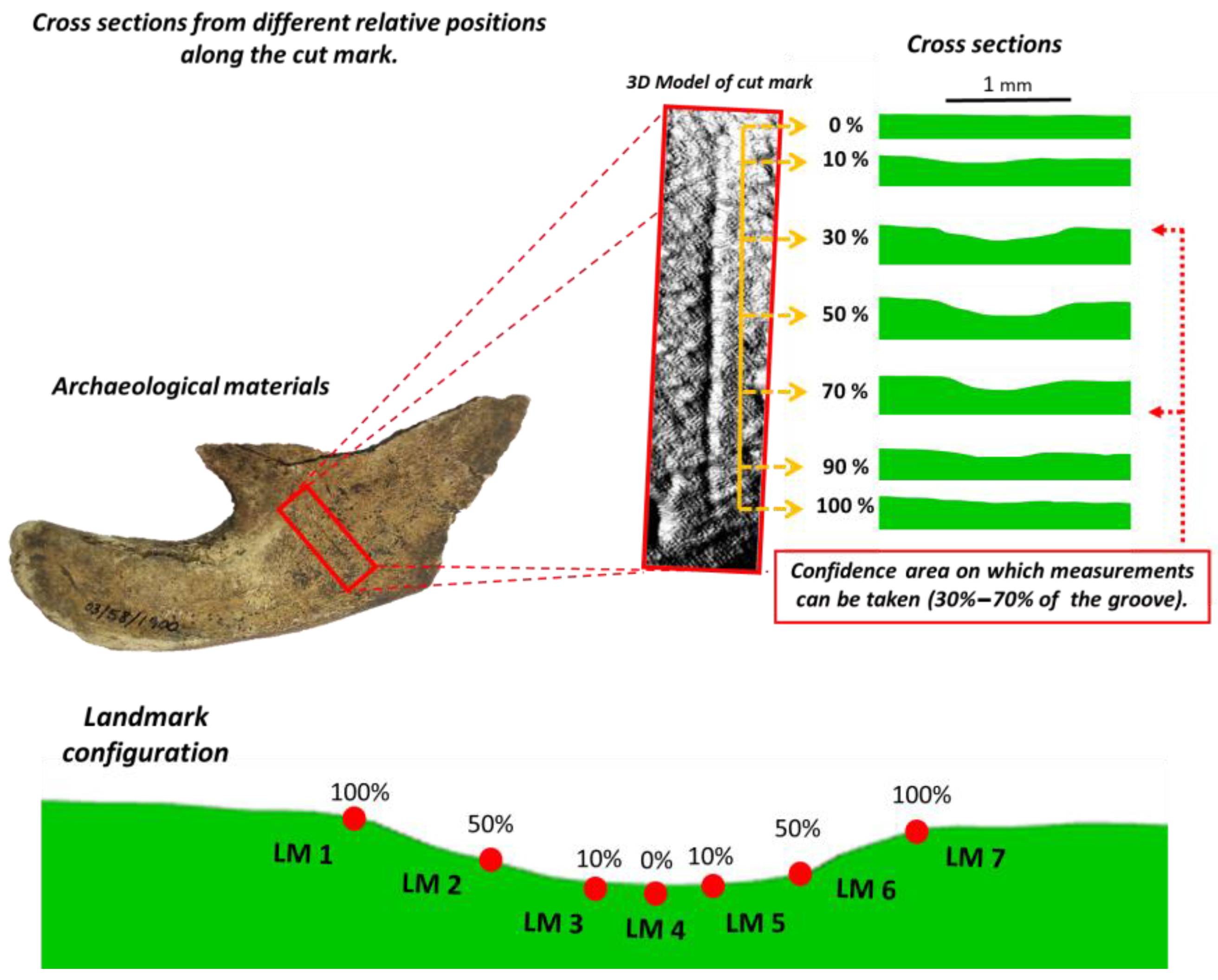

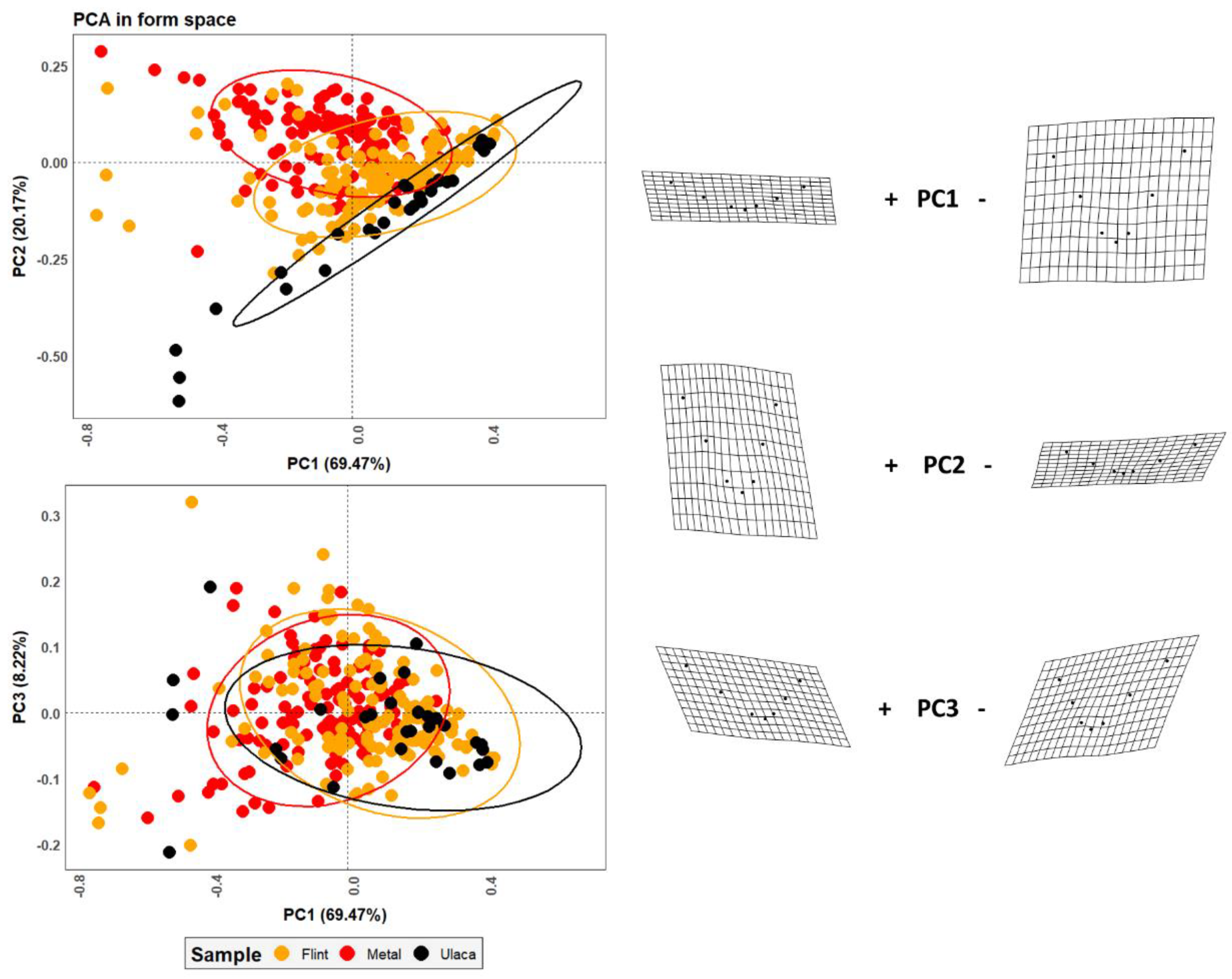
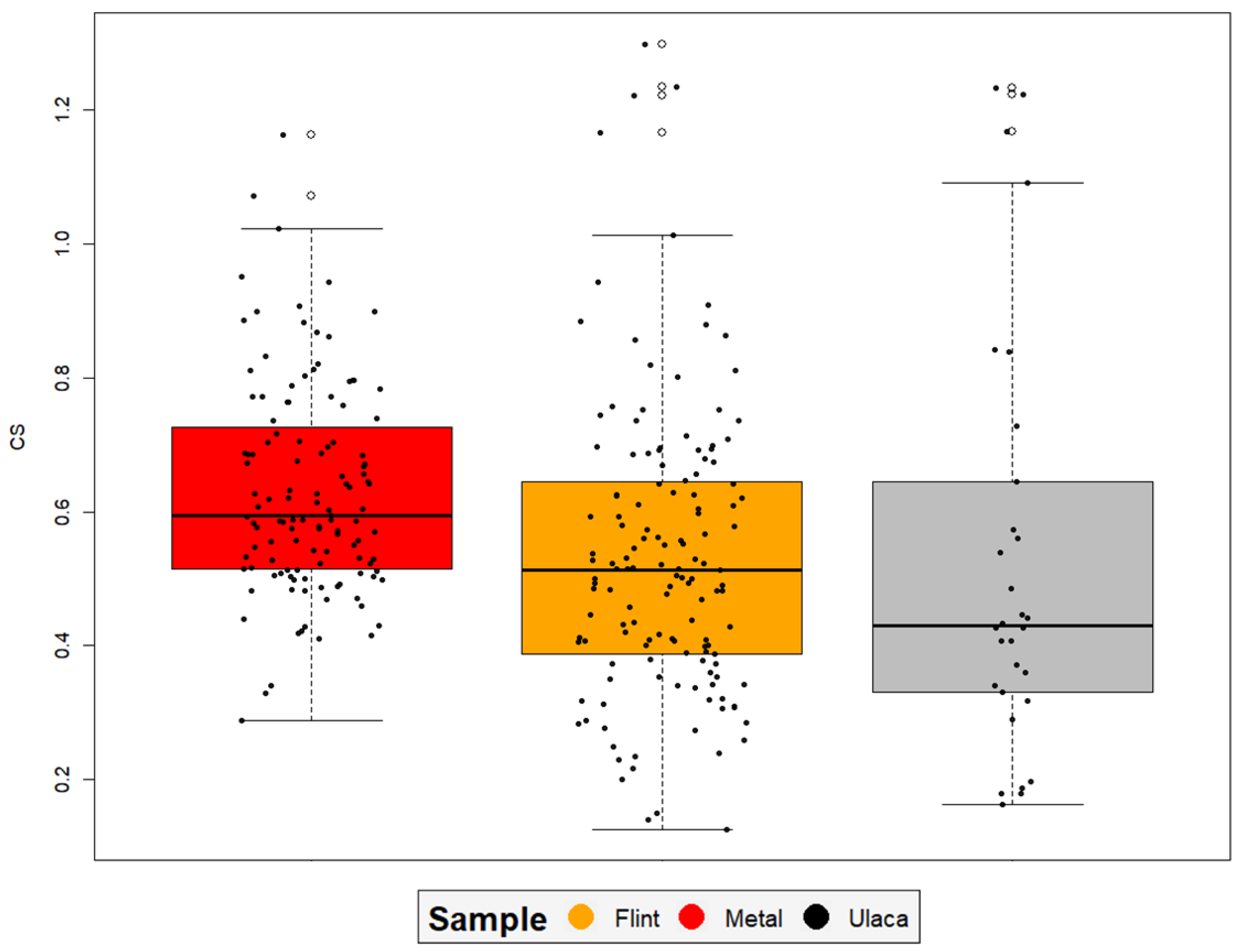
| Sample | N of Cut Marks | Carcass |
|---|---|---|
| Ulaca | 30 | Long bone shafts |
| Flint 1 | 36 | Long bone shafts |
| Flint 2 | 35 | Long bone shafts |
| Flint 3 | 37 | Long bone shafts |
| Flint 4 | 31 | Long bone shafts |
| Metal 1 | 60 | Long bone shafts |
| Metal 2 | 60 | Long bone shafts |
| Model | Description Model | R Library/Function | Tunning Parameters |
|---|---|---|---|
| RF | Random forests is an ensemble learning method for classification, regression and other tasks that operates by constructing a multitude of decision trees | caret [63] | number of trees, depth of trees, number of variables per split was calculated with the mtry function |
| GBM | Gradient boosting is a machine learning technique used in regression and classification tasks, that comprises an ensemble of decision trees built in a stage-wise fashion, to allow the optimization of the loss function | caret [63] | Hyperparameter grid was manually generated to calculate the optimal number of trees; the depth of the trees; the number of splits; the learning rate; and the L2 regularization |
| SVM | Support Vector Machine is a supervised machine learning algorithm used for classification or regression problems, that is based on the use of kernel tricks to find the optimal boundary between the data | caret [63] | Radial Basis Function (rbfdot) was selected, and optimal cost and gamma parameters were calculated using Bayesian Optimization Algorithms (BOAs) [64,65,66] |
| NN | Neural networks are computing systems inspired by the biological neural networks that constitute animal brains by generating a structure based on nodes displayed in hierarchical layers | nnet [67] and caret [63] | Hyperparameter grid was manually generated to find out the optimal number of neurons (1–20) and the optimal decay |
| Model | Accuracy | Kappa | Sensitivity | Specificity | Bal. Accuracy |
|---|---|---|---|---|---|
| shape | |||||
| RF | 0.9221 | 0.838 | 0.9032 | 0.9348 | 0.9190 |
| GBM | 0.9351 | 0.8698 | 0.9444 | 0.9268 | 0.9356 |
| SVM | 0.9221 | 0.838 | 0.9032 | 0.9348 | 0.9190 |
| NN | 0.974 | 0.946 | 0.9677 | 0.9783 | 0.9730 |
| form | |||||
| RF | 0.9221 | 0.8397 | 0.9355 | 0.9130 | 0.9243 |
| GBM | 0.9481 | 0.892 | 0.9355 | 0.9565 | 0.9460 |
| SVM | 0.9091 | 0.81 | 0.8710 | 0.9348 | 0.9029 |
| NN | 0.974 | 0.946 | 0.9677 | 0.9783 | 0.9730 |
Disclaimer/Publisher’s Note: The statements, opinions and data contained in all publications are solely those of the individual author(s) and contributor(s) and not of MDPI and/or the editor(s). MDPI and/or the editor(s) disclaim responsibility for any injury to people or property resulting from any ideas, methods, instructions or products referred to in the content. |
© 2023 by the authors. Licensee MDPI, Basel, Switzerland. This article is an open access article distributed under the terms and conditions of the Creative Commons Attribution (CC BY) license (https://creativecommons.org/licenses/by/4.0/).
Share and Cite
Maté-González, M.Á.; Estaca-Gómez, V.; Aramendi, J.; Sáez Blázquez, C.; Rodríguez-Hernández, J.; Yravedra Sainz de los Terreros, J.; Ruiz-Zapatero, G.; Álvarez-Sanchís, J.R. Geometric Morphometrics and Machine Learning Models Applied to the Study of Late Iron Age Cut Marks from Central Spain. Appl. Sci. 2023, 13, 3967. https://doi.org/10.3390/app13063967
Maté-González MÁ, Estaca-Gómez V, Aramendi J, Sáez Blázquez C, Rodríguez-Hernández J, Yravedra Sainz de los Terreros J, Ruiz-Zapatero G, Álvarez-Sanchís JR. Geometric Morphometrics and Machine Learning Models Applied to the Study of Late Iron Age Cut Marks from Central Spain. Applied Sciences. 2023; 13(6):3967. https://doi.org/10.3390/app13063967
Chicago/Turabian StyleMaté-González, Miguel Ángel, Verónica Estaca-Gómez, Julia Aramendi, Cristina Sáez Blázquez, Jesús Rodríguez-Hernández, José Yravedra Sainz de los Terreros, Gonzalo Ruiz-Zapatero, and Jesús R. Álvarez-Sanchís. 2023. "Geometric Morphometrics and Machine Learning Models Applied to the Study of Late Iron Age Cut Marks from Central Spain" Applied Sciences 13, no. 6: 3967. https://doi.org/10.3390/app13063967





